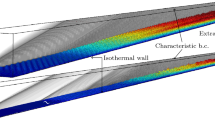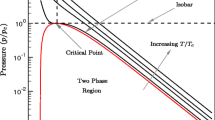Abstract
Moderate-resolution numerical simulations of the impulsive acceleration of a dense gas curtain in air by a Mach 1.21 planar shock are carried out by solving the 3D compressible multi-species Navier–Stokes equations coupled with localized artificial diffusivity method to capture discontinuities in the flow field. The simulations account for the presence of three species in the flow field: air, \(\hbox {SF}_6\) and acetone (used as a tracer species in the experiments). Simulations at different concentration levels of the species are conducted and the temporal evolution of the curtain width is compared with the measured data from the experimental studies by Balakumar et al. (Phys Fluids 20:124103–124113, 2008). The instantaneous density and velocity fields at two different times (prior and after the reshock) are compared with experimental data and show good qualitative agreement. The reshock process is studied by re-impacting the evolving curtain with the reflected shock wave. Reshock causes enhanced mixing and destroys the ordered velocity field causing a chaotic flow. The unsteady flow field is characterized by computing statistics of certain flow variables using two different definitions of the mean flow. The average profiles conditioned on the heavy gas (comprising \(\hbox {SF}_6\) and acetone) and the corresponding fluctuating fields provide metrics which are more suitable to comparing with experimentally measured data. Mean profiles (conditioned on the heavy gas) of stream-wise velocity, variance of stream-wise velocity, and turbulent kinetic energy and PDF (probability distribution function) of fluctuating velocity components are computed at two different times along the flow evolution and are seen to show trend towards grid convergence. The spectra of turbulent kinetic energy and scalar energy (of mass fraction of heavy gas) show the existence of more than half decade of inertial sub-range at late times following reshock. The Reynolds stresses in the domain are reported while identifying the term that is dominant in its contribution to the Reynolds stresses.




















Similar content being viewed by others
References
Brouillette, M.: The Richtmyer-Meshkov instability. Annu. Rev. Fluid Mech. 34, 445–468 (2002). http://www.annualreviews.org/doi/abs/10.1146/annurev.fluid.34.090101.162238
Vetter, M., Sturtevant, B.: Experiments on the Richtmyer-Meshkov instability of an air/SF6 interface. Shock Waves 4(5), 247–252 (1995)
Brouillette, M., Sturtevant, B.: Growth induced by multiple shock waves normally incident on plane gaseous interfaces. Physica D 37, 248–263 (1989)
Jones, M.A., Jacobs, J.W.: A membraneless experiment for the study of Richtmyer-Meshkov instability of a shock-accelerated gas interface. Phys. Fluids 9(10), 3078–3085 (1997)
Jacobs, J.W.: The dynamics of shock accelerated light and heavy gas cylinders. Phys. Fluids A 5, 2239–2248 (1993)
Balakumar, B.J., Orlicz, G.C., Tomkins, C.D., Prestridge, K.P.: Simultaneous particle-image velocimetry-planar laser-induced fluorescence measurements of Richtmyer-Meshkov instability growth in a gas curtain with and without re-shock. Phys. Fluids. 20, 124103–124113 (2008)
Gowardhan, A.A., Grinstein, F.F.: Numerical simulation of Richtmyer-Meshkov instabilities in shocked gas curtains. J. Turbul. 12(N43), 1–24 (2011)
Abgrall, R., Karni, S.: Computations of compressible multifluids. J. Comput. Phys. 169(2), 594–623 (2001)
Coquel, F., Almine, K.E., Godlewski, E., Perthame, B., Rascle, P.: A numerical method using upwind schemes for the resolution of two-phase flows. J. Comput. Phys. 136(2), 272–288 (1997)
Daly, B.J.: A technique for including surface tension effects in hydrodynamic calculations. J. Comput. Phys. 4(1), 97–117 (1969)
Harlow, F.H., Welch, J.E.: Numerical calculation of time-dependent viscous incompressible flow of fluid with free surface. Phys. Fluids 8(12), 2182–2201 (1965)
Jiang, G.S., Shu, C.W.: Efficient implementation of weighted ENO scheme. J. Comput. Phys. 126(1), 202–228 (1996)
Deng, X.G., Zhang, H.: Developing high-order weighted compact nonlinear schemes. J. Comput. Phys. 165, 22–44 (2000)
Martin, M.P., Taylor, E.M., Wu, M., Weirs, V.G.: A bandwidth-optimized WENO scheme for the effective direct numerical simulation of compressible turbulence. J. Comput. Phys. 220(1), 270–289 (2006)
Johnsen, E., Larsson, J., Bhagatwala, A.V., Cabot, W.H., Moin, P., Rawat, P.S., Shankar, S.K., Sjogreen, B., Yee, H.C., Zhong, X., Lele, S.K.: Assessment of high-resolution methods for numerical simulations of compressible turbulence with shock waves. J. Comput. Phys. 229(4), 1213–1237 (2010)
Lele, S.K.: Compact finite difference schemes with spectral-like resolution. J. Comput. Phys. 103(1), 16–42 (1992)
Gaitonde, D.V., Visbal, M.R.: Padé-type higher-order boundary filters for the Navier–Stokes equations. AIAA J. 38(11), 2103–2112 (2000)
Cook, A.W.: Artificial fluid properties for large-eddy simulation of compressible turbulent mixing. Phys. Fluids 19(5), 055103–055112 (2007)
Cook, A.W., Cabot, W.H.: A high-wavenumber viscosity for high-resolution numerical method. J. Comput. Phys. 195(2), 594–601 (2004)
Kawai, S., Lele, S.K.: Localized artificial diffusivity scheme for discontinuity capturing on curvilinear meshes. J. Comput. Phys. 227(22), 9498–9526 (2008)
Mani, A., Larrson, J., Moin, P.: Suitability of artificial bulk viscosity for large-eddy simulations of turbulent flows with shocks. J. Comput. Phys. 228(19), 7368–7374 (2009)
Bhagatwala, A., Lele, S.K.: A modified artificial viscosity approach for compressible turbulence simulations. J. Comput. Phys. 228(14), 4965–4969 (2009)
Kawai, S., Shankar, S.K., Lele, S.K.: Assessment of localized artificial diffusivity scheme for large-eddy simulation of compressible turbulent flows. J. Comput. Phys. 229(5), 1739–1762 (2010)
Cook, A.W.: Enthalpy diffusion in multicomponent flows. Phys. Fluids 21(5), 055109–055121 (2009)
Reid, R.C., Pransuitz, J.M., Poling, B.E.: The Properties of Gases and Liquids. Mc Graw Hill, New York (1987)
Ramshaw, J.D.: Self-consistent effective binary diffusion in multicomponent gas mixtures. J. Non-Equilib. Thermodyn. 15, 295–300 (1990)
Gaitonde, D. V., Visbal, M. R.: High-Order Schemes for Navier–Stokes Equations: Algorithm and Implementation into FDL3DI. AFRL-VA-WP-TR-1998-3060, Air Force Research Laboratory (1998)
Gaitonde, D.V., Shang, J.S., Young, J.L.: Practical aspects of high-order accurate finite-volume schemes for electromagnetics. AIAA Paper 97–0363, AIAA (1997)
Shankar, S.K., Kawai, S., Lele, S.K.: Two-dimensional viscous flow simulation of a shock accelerated heavy gas cylinder. Phys. Fluids 23(2), 024102–024114 (2011)
Rightley, P.M., Vorobieff, P., Benjamin, R.F.: Evolution of a shock accelerated thin fluid layer. Phys. Fluids 9, 1770–1782 (1997)
Jacobs, J.W., Jenkins, D.G., Klein, D.L., Benjamin, R.F.: Nonlinear growth of the shock-accelerated instability in a thin layer. J. Fluid Mech. 295(23), 1770–1783 (1995)
Chapman, S., Cowling, T.G.: The Mathematical Theory of Non-Uniform Gases: An Account of the Kinetic Theory of Viscosity. Thermal Conduction and Diffusion in Gases. Cambridge University Press, Cambridge (1990)
Acknowledgments
This work is supported by DOE-SciDAC (Grant DE-FC02-06-ER25787). We also acknowledge previous support for shock capturing using localized artificial diffusivity under AFOSR-MURI (Grant FA9550-04-1-0387). The present code is based on the extension to the code FDL3DI provided by Dr. M. R. Visbal, whom the authors thank. Computational time and resources have been provided by the Argonne Leadership Computing Facility (ALCF) and National Center for Computational Sciences (NCCS) under the INCITE award. We acknowledge Dr. Kathy Prestridge, Dr.Sridhar Balasubramanian, Dr. B.J. Balakumar and Dr. Greg Orlicz at Los Alamos National Laboratory for insightful discussions and providing experimental data during the analysis of the problem. This document reports results obtained using the facilities of the US Department of Energy (DOE) which are managed by UChicago Argonne, LLC (Contractor). Neither Contractor DOE, the US Government nor any person acting on their behalf: (a) makes any warranty or representation, express or implied, with respect to the information contained in this document; or (b) assumes any liabilities with respect to the use of, or damages resulting from the use of, any information contained in the document.
Author information
Authors and Affiliations
Corresponding author
Additional information
Communicated by R. Bonazza and K. Kontis.
The paper was based on work that was presented at the 28th International Symposium on Shock Waves, 17–22 July, 2011, Manchester, UK.
Appendices
Appendix A: Artificial diffusivity method
The localized artificial diffusivity method formulated on a generalized multi-dimensional coordinate system is given below:
The method is the extension of the original artificial viscosity scheme proposed by Cook [18], Kawai and Lele [20] (modification to curvilinear mesh) and Mani et al. [21] (dilatation based bulk viscosity with the length scaling modification). \(C_\mu ,C_\beta ,C_\kappa ,C_{D_k}\) and \(C_{Y_k}\) are dimensionless user-specified constants. \(c_\mathrm{s}\) is the speed of sound, and \(H\) is the Heaviside function. \(\xi _{l}\) refers to generalized coordinates \(\xi ,\eta \) and \(\zeta \) when \(l\) is 1, 2 and 3, respectively. \(\varepsilon =10^{-32}\) is a small positive constant to prevent division by zero in the region where both \(\nabla \cdot {\varvec{u}}\) and \(\nabla \times {\varvec{u}}\) are zero. The overbar denotes an approximate truncated-Gaussian filter [19]. The \(f_\mathrm{sw}\) in (30) is the switching function that is designed to help localize the artificial bulk viscosity only near shock waves.
\(\Delta \xi _{l}\) and \(\Delta _{l, \bullet }\) are the grid spacing in the computational space and physical space. Usually, \(\Delta \xi _{l}\) is set to 1. We define the grid spacing \(\Delta _{l, \bullet }\) as follows:
\({\varvec{\Delta }}{\varvec{x}}_{\varvec{l}}\) is the local displacement vector along the grid line in the \(\xi _{l}\) direction and is defined as
where the nodes in the \(\xi _{l}\) direction are indexed by \(i\). Thus, \(\Delta _{l,\beta },\Delta _{l,\kappa }\) and \(\Delta _{l, D_k}\) are the grid spacing in the \(\xi _{l}\) direction perpendicular to the shock waves, contact surfaces and material discontinuities. \(\Delta _{Y_{k}}\) in (32) is the grid spacing in the physical space defined by \(\Delta _{Y_{k}} = \frac{ \sum ^{3}_{l=1} \left| \frac{\partial ^{4}Y_k}{\partial \xi _{l}^{4}} \right| \Delta _{l, D_k}}{ \sqrt{\sum ^{3}_{l=1} \left( \frac{\partial ^{4}Y_k}{\partial \xi _{l}^{4}} \right) ^2} + \varepsilon }\).
Appendix B: Viscosity coefficient [32]
The viscosity of a pure gas species \(i\) is given by:
where \(\sigma _i\) is the collision diameter and \(\varOmega _{\mu ,i}\) is the collision integral:
in which \(T_i^*=T/T_{\epsilon ,i}\) and \(A=1.16145\), \(B=0.14874\), \(C=0.52487\), \(D=0.77320\), \(E=2.16178\), \(F=2.43787\), \(T_{\epsilon ,i}=\epsilon _i/k_\mathrm{B}\) is the effective temperature characteristic of the force potential function (\(k_\mathrm{B}\) is the Boltzmann constant). The values of \(\sigma _i\) and \(\epsilon _i\) for the different species of interest are given below. Air is regarded as a mixture of nitrogen and oxygen in the ratio of 71:29, respectively.
Appendix C: Diffusion coefficient [32]
The diffusion coefficient in a binary mixture of two species \(i\) and \(j\) is given as:
The collision integral for diffusion is given by:
where \(M_{ij}=\frac{2}{\frac{1}{M_i}+\frac{1}{M_j}},\,A=1.06036,\, B=0.15610,\,C=0.19300,\,D=0.47635,\,E=1.03587,\, F=1.52996,\,G\!=\!1.76474\) and \(H=3.89411\). \(\sigma _{ij}=\frac{\sigma _i+\sigma _j}{2},\,T_{ij}^* = T/T_{\epsilon ,ij}\) and \(T_{\epsilon ,ij}=\sqrt{\frac{\epsilon ^i}{k_\mathrm{B}}\frac{\epsilon ^j}{k_\mathrm{B}}}\). The value of Lennard Jones potentials \((\epsilon /k_\mathrm{B}\) and \(\sigma )\) are given in Table 2. Air is regarded as a mixture of nitrogen and oxygen in the ratio of 71:29, respectively.
Appendix D: Contribution of the artificial property
The role of the artificial property in the simulated results is characterized in this section by comparing the magnitude of the artificial property in the governing equations to the corresponding molecular property of the fluid. Of particular interest is the artificial diffusivity term which is added to the RHS of the scalar mass fraction equation. The cross section averaged profiles of the artificial diffusivity is plotted with the corresponding species diffusivity (between \(\hbox {air-SF}_6\)) at two different times in Fig. 21. The artificial diffusivity dominates the species diffusivity in the coarse mesh simulations, while on the finer mesh, the magnitudes of the artificial and the molecular property terms remain comparable indicating that the artificial property model is active on the fine grid resolutions explored here. At early times, the molecular diffusivity in the flow domain is larger than the artificial diffusivity introduced by the localized artificial diffusivity method. Hence, good comparison of the numerical results with the experimental data suggests that the artificial property method which is active in the numerical simulations is able to robustly handle the material discontinuities in the flow field and leads to a good prediction of this unsteady multi-component compressible flow.
Rights and permissions
About this article
Cite this article
Shankar, S.K., Lele, S.K. Numerical investigation of turbulence in reshocked Richtmyer–Meshkov unstable curtain of dense gas. Shock Waves 24, 79–95 (2014). https://doi.org/10.1007/s00193-013-0478-z
Received:
Revised:
Accepted:
Published:
Issue Date:
DOI: https://doi.org/10.1007/s00193-013-0478-z





